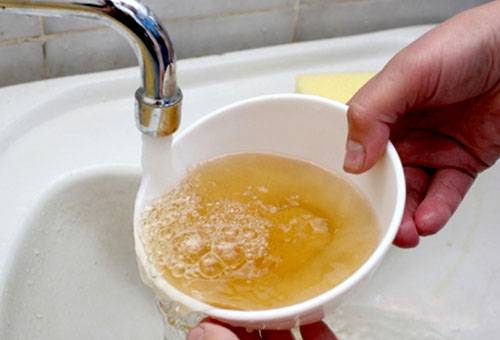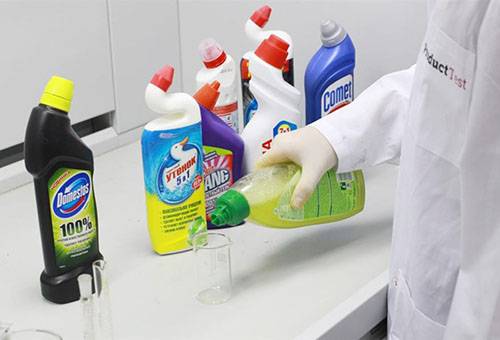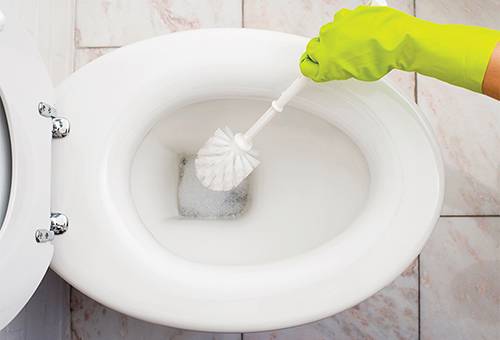How to easily clean the toilet, remove rust and limescale?
It's nice when home plumbing gets its original whiteness and shines with cleanliness. How to clean the toilet from brown plaque? What means to apply to remove stone and rust without titanic efforts? We will find out why plaque and rust form on the toilet and inside the tank, and also consider the main cleaning products, their advantages and disadvantages.
Why does a plaque form?
To understand how to clean the toilet at home, you need to determine what type of pollution is preferable in your case. There are few hard to remove contaminants, usually they are as follows.
- Urinary stone. It consists of complex mineral salts that fall on the surface of the toilet bowl and under the rim with urine. Often the problem appears in families where households forget to flush after themselves in the toilet or the toilet itself is rarely subjected to preventive treatment. If the urinary stone has already formed, then it is difficult to get rid of it, ordinary remedies cope with it poorly.
- Limescale coating. In houses with increased water hardness, the calcium salts contained in it eventually settle in the tank and on the walls of the toilet. On top of the limescale, various types of contaminants quickly accumulate. To whiten the toilet, in this case, acid-based products are used.
- Rust. The appearance of rusty drips is also associated with water quality. It can be old, rusty water pipes or water with a high iron content from the well.
Mechanical damage to faience contributes to the accumulation of dirt. No need to wash the surface of the toilet bowl and the drain tank with metal brushes or rough abrasive materials. Also, hot water cannot be poured into the toilet - this causes microcracks to form on the surface.
To improve the quality of water, various filters are used or prophylactic agents in the form of special blisters and tablets are constantly added to the toilet bowl.
Household chemicals
The easiest way to properly remove urinary stone and rust is by using household cleaning products designed for toilets. The industry offers many solutions and powders, but all of them can be divided into four categories.
- Chlorine based products. Perfectly wash and disinfect the surface, do not corrode faience and do not leave behind microcracks. Eliminate odors, but they themselves smell not very pleasant. Suitable for daily care of plumbing.
- Alkaline products. These are liquid solutions containing sodium hydroxide. Such tools can get rid of surface contaminants, they practically do not smell, disinfect well and do not damage the surface of the toilet. Alkalis perfectly dissolve fats, therefore, it is recommended to wash plumbing with such agents with blockages of organic origin.
- Acid-based products. These chemicals go into battle against old deposits of urinary stone, rust. With their help, you can remove limescale in the toilet. Most often, the composition of the product includes oxalic, formic, phosphoric, hydrochloric acids, or a mixture thereof. It is not recommended to often wash faience and ceramics with acid, since it corrodes the surface to some extent, in addition, pairs of acids have a bad effect on health.
- Cleaning powders. To remove the stone from the tank and toilet bowl, you need to drain and scoop up water, and then wipe off the dirt with a powder using a hard non-metallic sponge.With frequent use, such powders also contribute to the appearance of roughness on the surface of the plumbing, in which dirt will accumulate.
Tip
When choosing a toilet cleaner, give preference to gels and cream formulations. Compared to liquid and powdered products, they are more economical and easy to use.
As for specific brands, judging by user reviews, Silit, Toilet duckling and Sanitary Gel cope with all types of pollution. Domestos and Breff remove rust well. Universal products intended not only for toilets, but also for ceramic tiles - “Comet Universal”, “Santri”, “Sanitol”, “Sarma”, “WC 5+ gel” - are suitable for daily care, sanitation and removal of fresh deposits .
Folk remedies
To clean the toilet from urinary stone, you can resort to the help of folk remedies. Water is removed from the toilet and the tank, the product is applied for about one hour, then the surface needs to be washed with a brush or a hard sponge. Do not forget to use rubber gloves - almost all compounds act aggressively on the skin of the hands.
- Acetic essence. This is pure, undiluted vinegar, which is sold in small glass bottles. To put on the polluted places, in an hour to rub with a brush.
- Lemon acid. Two to three tablespoons of acid are poured into the toilet bowl and a tank of water, left for several hours. Then you can just rinse with water or even brush with a brush. Repeat several times until all the plaque can be washed.
- Vinegar and iodine. Table vinegar (9%) in the amount of one glass is heated to a temperature of 40-50 ° C. Add a little soda or iodine solution to the heated solution. Pour the mixture into the toilet bowl without water, close the lid and leave overnight.
- Coca-Cola or Whiteness. Using these tools, you can bleach the toilet and remove rust and stone. Pour 1-1.5 liters of the product into a dry toilet bowl and leave overnight.
If it is not possible to remove the contamination the first time, repeat until the desired result is achieved. Sometimes old, accumulated deposits over the years are not amenable to any effort. Then the "heavy artillery" is used.
Take tough measures
Complex contaminants are removed with concentrated acids. When working with chemicals at home, use rubber gloves, a protective gown or a plastic apron and a respirator. Do not close the door to the toilet, and after processing, flush the toilet thoroughly, ventilate the room as a whole.
- Dry oxalic acid. Technical acid is sold in powder form. It is applied to a piece of cloth and the dirt is wiped off manually. To wash the toilet in this way with the observance of precautions.
- Electrolyte for acid batteries. This substance allows you to get rid of stubborn plaque. Contains concentrated acid. Do not use if sewer pipes are made of plastic. Pour into the toilet, after half an hour or an hour, wash off with water.
- Hydrochloric acid. Sold in plumbing stores, usually used to clean water heaters in gas boilers, columns, etc. The principle is the same as with electrolyte. With its help, you can get rid of all types of stone.
- Iodine Chloride A liquid remedy, you can buy it in veterinary pharmacies. Perfectly removes all types of stone. The solution is watered over the contaminated areas and washed off immediately with water - the product eats away the lime deposits and rust within a few minutes. Cannot be used in homes where sewer pipes are made of cast iron. Also, iodine monochloride is aggressive to aluminum.
And finally, we note that it is too often undesirable to use potent agents - they spoil the surface of the plumbing, leaving microdamages on it. After washing once the limescale and stone, regularly reorganize the toilet.If there is poor water, install house filters or use special tablets to prevent the formation of plaque in the tank and toilet.




I'm genius. I figured out how to remove a stone
A screwdriver with a flat nozzle and a hammer is taken. Put the tip of the screwdriver on your toilet stone near the edge, gently hit the screwdriver with a hammer and the piece of stone breaks off, and go further, sometimes a large piece of stone breaks off. If you knock lightly, the metal screwdriver of the toilet itself will not touch. If you pre-soften Coca-Cola will be even better. This can be done in water, but can be drained. How to drain, I also came up with. Take a plastic bottle, wrinkle it, dip the spout in the water and straighten the bottle, it sucks the water from the toilet.
Alina, many thanks, we will use your advice and the author of the article.
And why bring to the point that the stone needs to be beaten off !?